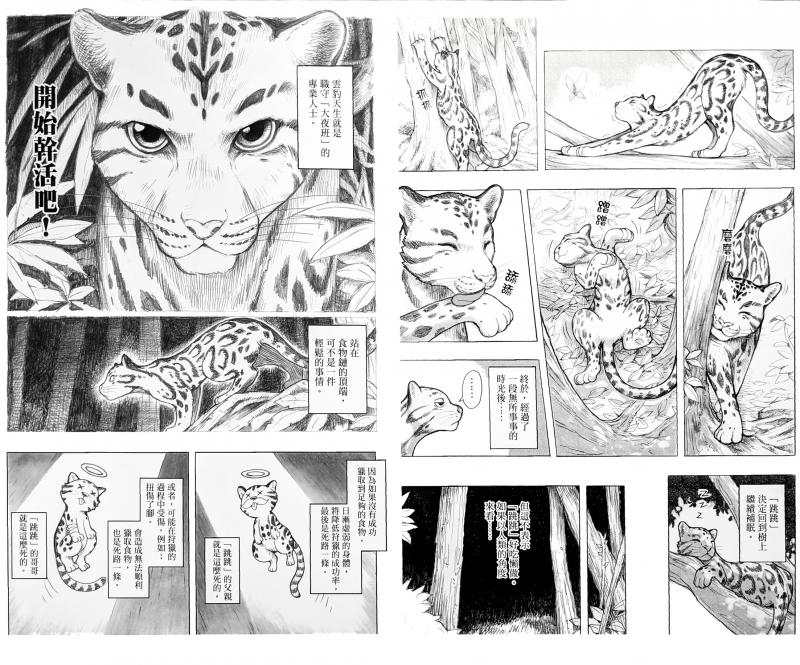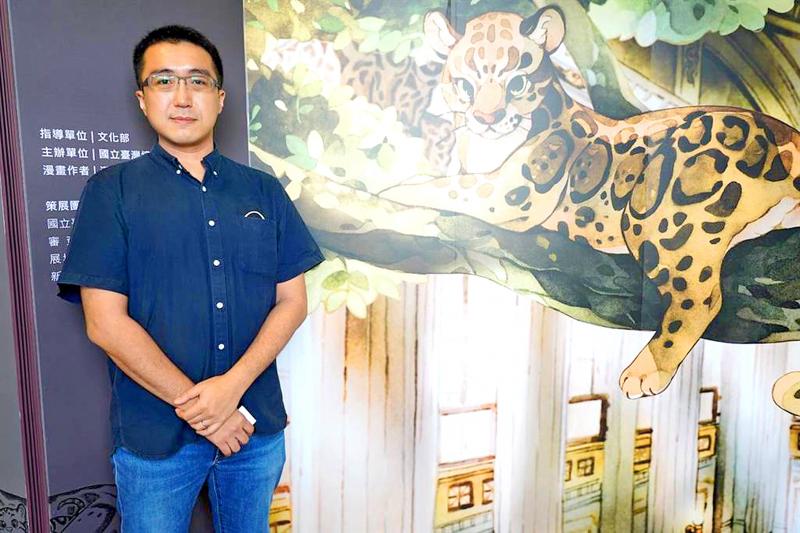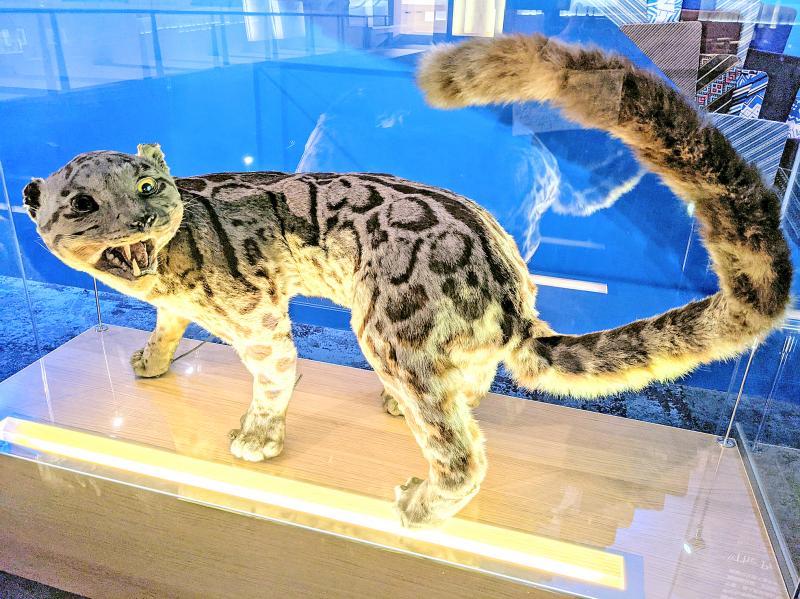Comic artist Hambuck (漢寶包) worried that the outline for his new work was too whimsical. After all, the client was the National Taiwan Museum (國立台灣博物館), one of the nation’s oldest and respected institutes dedicated to Taiwan’s flora, fauna, history and culture.
Museum director Hung Shih-yu (洪世佑) did give Hambuck flack after reading the plot featuring cloud leopards — but for being too conservative.
“He wanted it to be more inventive and asked, ‘Do you know Marvel?’ I saw that as a green light to step all the way down on the pedal and charge forward,” the award-winning artist says.

Photo: Han Cheung, Taipei Times
Released on Nov. 18, Beasts of the Cloud (雲之獸) briefly mentions a “Cloud Leopard-man,” near the end, but that’s the extent of its connection to the superhero genre. A touching ode to the majestic big cat declared extinct in 2013 despite alleged sightings, the story traces several generations of talking cloud leopards from when they were abundant to the last one being immortalized as a specimen in the museum. Its spirit lingers in the museum, and eventually befriends a paranormal sensitive staff member. The museum has seven specimens in its collection, with one on display on the third floor.
Despite the creative freedom he was allowed, Hambuck, whose real name is Hsiao Nai-chung (蕭乃中), spent a year doing research, working with museum staff and experts and perfecting his illustrations of the elusive animal, which he admits he was not familiar with before he started the work.
“I thought it was much bigger,” he says. “My assistant kept asking me at first, why is the size varying so much in your drawings?”

Photo courtesy of National Taiwan Museum
Museum researchers painstakingly checked the fur patterns on each panel or accuracy, and paid special attention to the parts that feature Aboriginal culture — even bringing in outside experts to avoid violating cultural taboos.
Hambuck bravely plunged into the comic world in 2005 when there was barely an industry, but he didn’t start creating Taiwan-specific works until 2014’s Dragon Swordsman vs The Mistery Man (龍泉俠大戰迷霧人), which is rooted in traditional puppetry.
“Having lived abroad for many years, I didn’t feel a strong calling to do something for Taiwan,” he says. “There’s actually a lot of [local material] that we [artists] can work with, but we just weren’t used to digging for it. We just wanted to draw what was cool and exciting.”

Photo: Han Cheung, Taipei Times
His interest was piqued by Academia Sinica’s Creative Comic Collection project, which regularly holds events to suggest intriguing and relevant Taiwanese cultural themes to local artists. Hambuck linked up with the museum at one of the meetings, who commissioned him to create a work on any artifact he wanted.
Hambuck quickly decided on the cloud leopard after seeing the specimen on display.
“They say that it’s extinct, but there’s people who dispute that ... There’s a lot of room for imagination,” he says. “At first, my idea was just to use the leopard’s eyes as a camera lens to tell a story, but as I delved deeper into the work, the leopard’s presence and visibility became increasingly prominent.”
He laughs that he often goes wild in his own world when he creates, and is glad that the museum was cool with even the paranormal parts.
Although the story’s details are carefully verified, Hambuck doesn’t see it as an informational or educational comic; he cares about telling a good story.
“If the comic piques someone’s interest in the museum, I have achieved my mission,” he says.

On April 26, The Lancet published a letter from two doctors at Taichung-based China Medical University Hospital (CMUH) warning that “Taiwan’s Health Care System is on the Brink of Collapse.” The authors said that “Years of policy inaction and mismanagement of resources have led to the National Health Insurance system operating under unsustainable conditions.” The pushback was immediate. Errors in the paper were quickly identified and publicized, to discredit the authors (the hospital apologized). CNA reported that CMUH said the letter described Taiwan in 2021 as having 62 nurses per 10,000 people, when the correct number was 78 nurses per 10,000

As we live longer, our risk of cognitive impairment is increasing. How can we delay the onset of symptoms? Do we have to give up every indulgence or can small changes make a difference? We asked neurologists for tips on how to keep our brains healthy for life. TAKE CARE OF YOUR HEALTH “All of the sensible things that apply to bodily health apply to brain health,” says Suzanne O’Sullivan, a consultant in neurology at the National Hospital for Neurology and Neurosurgery in London, and the author of The Age of Diagnosis. “When you’re 20, you can get away with absolute

May 5 to May 11 What started out as friction between Taiwanese students at Taichung First High School and a Japanese head cook escalated dramatically over the first two weeks of May 1927. It began on April 30 when the cook’s wife knew that lotus starch used in that night’s dinner had rat feces in it, but failed to inform staff until the meal was already prepared. The students believed that her silence was intentional, and filed a complaint. The school’s Japanese administrators sided with the cook’s family, dismissing the students as troublemakers and clamping down on their freedoms — with

As Donald Trump’s executive order in March led to the shuttering of Voice of America (VOA) — the global broadcaster whose roots date back to the fight against Nazi propaganda — he quickly attracted support from figures not used to aligning themselves with any US administration. Trump had ordered the US Agency for Global Media, the federal agency that funds VOA and other groups promoting independent journalism overseas, to be “eliminated to the maximum extent consistent with applicable law.” The decision suddenly halted programming in 49 languages to more than 425 million people. In Moscow, Margarita Simonyan, the hardline editor-in-chief of the